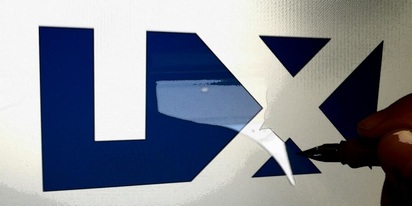'Majority overlap' is the name for the set of experience attributes that exist for a majority of users. This phenomenon exists at the heart of UX design.
Majority overlap works like this:
Majority overlap works like this:
Three people need to use a train service.
Person 1 needs to go to work at the same time every day. He wants to stop driving his poison-machine of a car, and see if catching the train gets him there just as fast with less carbon emissions.
Person 2 needs to get to town for a coffee date one time. Depending how the date turns out, there may be subsequent dates and subsequent train rides.
Person 3 is going on a multi-day train tour exploring the railway history of the country.
Each person has a list of experience attributes that could look like this:
The experience attributes of person 1:
Trip recurrence: determined by all requirements being met
Arrival time: reliable
Duration: short
Stress level: lower than driving
Carbon emissions: lower than driving
Safety: adequate
The experience attributes of person 2:
Trip recurrence: determined entirely by external factors
Arrival time: reliable
Safety: adequate
The experience attributes of person 3:
Recurrence determined by user enjoyment requirement AND external factors (budget)
Arrival time irrelevant
Duration: long
Enjoyment: high
Safety: adequate
Majority overlap in this example is the list of experience attributes shared by 2 or more (in this case 66% or more) of users. In this case only these factors comprise the majoriy overlap of experience attributes:
Safety: adequate (relevant to 100% of users)
Arrival time: reliable (relevant to 66% of users)
Trip recurrence: determined by UX (relevant to 66% of users)
Majority overlap is what a UX designer needs to spend most (not all) of their effort to optimise, because they are demonstrably the most important aspects of the general user experience. Getting things right beyond those core aspects has a lower ROI, and is can be more difficult due to potentially conflicting requirements between subsets of users -- consider the conflict between users' experiences in our example: "Duration: short" and and "Duration: long" are each viewed as favourable by Person 1 and Person 3 respectively. User preference conflicts = complexity (i.e. making the experience configurable by the user), and there's a line must to be drawn between investment in developing that complexity vs the cost of lost usership resulting from that complexity's absence.
Our example looks at 3 users. When your user base is millions of individuals, you might define "majority" more like 99.9999% than 66%. The larger your defined 'majority' the smaller your 'majority overlap' of experience attributes.
It's easy to make assumptions about what aspects of the experience comprise the 'majority overlap' when embarking on a project. Sometimes that's perfectly adequate.
But the most effective means is to analyse usage data and aggregate user feedback whenever it's available. This allows you to determine the majority overlap in empirical terms, and focus effort where it will benefit the majority of your users.
Thanks for learning!
Michael
Person 1 needs to go to work at the same time every day. He wants to stop driving his poison-machine of a car, and see if catching the train gets him there just as fast with less carbon emissions.
Person 2 needs to get to town for a coffee date one time. Depending how the date turns out, there may be subsequent dates and subsequent train rides.
Person 3 is going on a multi-day train tour exploring the railway history of the country.
Each person has a list of experience attributes that could look like this:
The experience attributes of person 1:
Trip recurrence: determined by all requirements being met
Arrival time: reliable
Duration: short
Stress level: lower than driving
Carbon emissions: lower than driving
Safety: adequate
The experience attributes of person 2:
Trip recurrence: determined entirely by external factors
Arrival time: reliable
Safety: adequate
The experience attributes of person 3:
Recurrence determined by user enjoyment requirement AND external factors (budget)
Arrival time irrelevant
Duration: long
Enjoyment: high
Safety: adequate
Majority overlap in this example is the list of experience attributes shared by 2 or more (in this case 66% or more) of users. In this case only these factors comprise the majoriy overlap of experience attributes:
Safety: adequate (relevant to 100% of users)
Arrival time: reliable (relevant to 66% of users)
Trip recurrence: determined by UX (relevant to 66% of users)
Majority overlap is what a UX designer needs to spend most (not all) of their effort to optimise, because they are demonstrably the most important aspects of the general user experience. Getting things right beyond those core aspects has a lower ROI, and is can be more difficult due to potentially conflicting requirements between subsets of users -- consider the conflict between users' experiences in our example: "Duration: short" and and "Duration: long" are each viewed as favourable by Person 1 and Person 3 respectively. User preference conflicts = complexity (i.e. making the experience configurable by the user), and there's a line must to be drawn between investment in developing that complexity vs the cost of lost usership resulting from that complexity's absence.
Our example looks at 3 users. When your user base is millions of individuals, you might define "majority" more like 99.9999% than 66%. The larger your defined 'majority' the smaller your 'majority overlap' of experience attributes.
It's easy to make assumptions about what aspects of the experience comprise the 'majority overlap' when embarking on a project. Sometimes that's perfectly adequate.
But the most effective means is to analyse usage data and aggregate user feedback whenever it's available. This allows you to determine the majority overlap in empirical terms, and focus effort where it will benefit the majority of your users.
Thanks for learning!
Michael


 RSS Feed
RSS Feed
